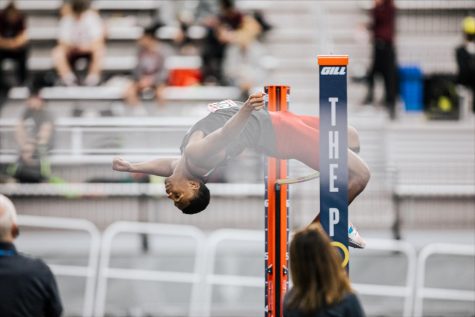Track and field returns to the Palouse for meet in the Bubble
February 3, 2017
This weekend the WSU bubble will host the 2017 Cougar Indoor Invitational track and field meet.
The meet will kick off at 12:30 p.m. on Friday with the 60-meter hurdles, the first event of the women’s pentathlon. The Cougar Indoor Invitational will conclude with the women’s 1600-meter relay at 4:30 pm on Saturday.
For those unfamiliar with track and field, an invitational means participants at this meet have specifically been invited to be there. This means the athletes visiting WSU this weekend will come from colleges of various sizes and levels, mostly in the Pacific Northwest.
The invitational, the sixth meet on the indoor schedule for WSU, is part of a ramp up to the NCAA Indoor Championships on March 10 and 11 in College Station, Texas. The outdoor season, the more traditional brand of the sport, will begin for the Cougars on March 17 in Los Angeles with the USC Trojan Invitational.
Indoor track and field is the HGTV of sports, in that it ignores both the laws of physics and nature; and the Property Brothers look like they pole vaulted in college.
Despite the cold, snowy conditions on the streets of Pullman, it is a balmy 71 degrees in the Bubble as runners sprint across the finish line.
Indoor track and field would be Hank Scorpio’s favorite sport, the megalomaniac, Silicon Valley prototype from The Simpsons. Just because you can play baseball on a blimp doesn’t mean you should.
I remember the moment I fell in love with track and field as a high school junior competing in an away meet at Rainier Beach High School. The reddish, orange sunset splattered across the sky that April night, a classic post-ear Van Gogh canvas. I can still feel the clement spring air stick to my skin like a post-it.
Reflecting on this reverence, I wonder is it possible to have the same connection to indoor track and field? It makes sense that the regular season would have a spin off; Cheers must have its Frasier after all. Athletes have to stay in shape during the cold winter so their bodies are not startled by the start of the season in March.
In addition, the length of a typical indoor track and field venue’s lap is 200 meters instead of the traditional 400 for outdoor tracks. Why would a major league baseball team play half of their season at a Little League field? Would the NBA play their summer league using a series of Pop-A-Shots placed strategically around the hardwood?
I would speculate whether this quicker turnaround has an undesirable effect on the shins, feet, and ankles of runners, particularly sprinters. Perhaps runners have consciously become accustomed over time to the smaller track but it still affects their running style on a subconscious level. It is comparable to how some major leaguers will experience post Home Run Derby droughts since they unknowingly altered their swing to be more powerful for the competition.
Alas, it will be an exciting weekend in the bubble on the campus of WSU with the return of indoor track and field.
Chris Arneson is a senior sports management major from Bothell. He can be contacted at 335-2290 or by [email protected].




















